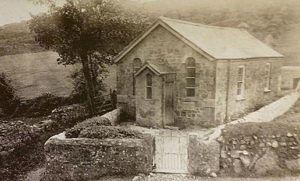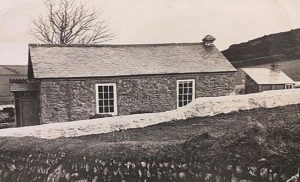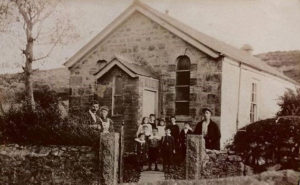
Bolenowe is a village in west Cornwall approximately one-and-a-half miles southeast of Camborne. This profile of Bolenowe Wesleyan Chapel has been compiled by Jo Lewis and Tony Mansell.
Wesleyan chapel, now converted to house and altered. Rendered walls. Altered windows that used to have pointed arches. Now almost unrecognisable as a former chapel except for forecourt walls (b1). Heritage Gateway)
Eventually on our walk we descend to the little village of Bolenowe, a settlement steeped in local Methodist history. Formerly it had two Methodist chapels, despite its small size, though now there is no place of worship in the village at all.
Down in Bolenowe itself we can take a lane to the right and this brings us to the location of the original Wesleyan chapel. In a previous post we have mentioned Bolenowe mine agent and farmer, Captain James Thomas (1778-1867). Class meetings were begun in his house when he was quite a young age and, when he was a boy of about 11, a memorable event occurred on Sunday 16th August 1789 when he walked through the lanes and trackways from Bolenowe to Gwennap Pit to hear the Revd John Wesley preach, in the place which Wesley himself referred to as the ‘amphitheatre’. Wesley had begun to preach there in the year 1762 but this occasion in 1789 marked the eighteenth and last occasion Wesley preached there, before his death two years later in 1791. It was also his last visit to Cornwall. There was a great crowd on that occasion and James Thomas of course lived until he was 89 in 1867. Therefore, in the seventh decade of the nineteenth century there was still alive in the Camborne area a person who had personally heard Wesley preach. In August 1789 of course the times were very stirring, as the French Revolution with the overthrow of the Ancient Regime had only occurred in the previous month.
It has been said that John Wesley himself on one occasion stayed the night at James Thomas’ house at Bolenowe, but we are not told the date that this occurred. However, the first Wesleyan chapel in Bolenowe was later constructed on the other side of the lane from the thatched cottage of the Thomas family and remained open for many years. In 1949-1950 the Society merged with the congregation of the former United Methodist Free Church in Bolenowe, which was situated further down on the main road route through the village and became one Society. The ex-Wesleyan chapel was closed for worship in 1950 and was sold in 1957, though there is sale correspondence covering the period 1956 to 1961 in the Redruth archives. John Dennis, who was for a number of years the treasurer of the Wesleyan chapel, around 1931 wrote an interesting account of early Wesleyan Methodism at Bolenowe, Troon and Plantation within the pages of the chapel’s account book, deposited at Kresen Kernow. He died in 1936. As has been pointed out to me there is a stone to James Thomas’ memory in the lane. I do not have any early interior images of this Wesleyan chapel up the lane in my collection but would love to find one. Can anyone oblige? (David Thomas of Camborne)
 Our first picture is a postcard view, probably by W J Bennetts of the James Thomas thatched cottage with the Wesleyan chapel opposite, dating from the early 1900s. The residence must date from the eighteenth century, or possibly even earlier, and was a longstanding structure. (Photo: David Thomas of Camborne)
Our first picture is a postcard view, probably by W J Bennetts of the James Thomas thatched cottage with the Wesleyan chapel opposite, dating from the early 1900s. The residence must date from the eighteenth century, or possibly even earlier, and was a longstanding structure. (Photo: David Thomas of Camborne)
 The second photograph shows some typed and handwritten information on the back of another copy of image number one in my possession. This refers to class meetings being held in the house before 1790 and the Revd John Wesley staying at the house. This other copy of the postcard formerly belonged to the late Tom Harris, an old Centenary boy and a Local Preacher in the former Camborne Circuit. (Photo: David Thomas of Camborne)
The second photograph shows some typed and handwritten information on the back of another copy of image number one in my possession. This refers to class meetings being held in the house before 1790 and the Revd John Wesley staying at the house. This other copy of the postcard formerly belonged to the late Tom Harris, an old Centenary boy and a Local Preacher in the former Camborne Circuit. (Photo: David Thomas of Camborne)
 The third picture is of the Wesleyan chapel building, with a little lane leading up to its left, probably taken in around 1920-1930. (Photo: David Thomas of Camborne)
The third picture is of the Wesleyan chapel building, with a little lane leading up to its left, probably taken in around 1920-1930. (Photo: David Thomas of Camborne)
 The fourth postcard is undated but is a W J Bennetts view looking north of the chapel in the early 1900s (Photo: David Thomas of Camborne)
The fourth postcard is undated but is a W J Bennetts view looking north of the chapel in the early 1900s (Photo: David Thomas of Camborne)
 A charming postcard view from the same era looking through the chapel’s entrance gate with some locals posing for the camera. Note that the same tree occurs in all four photographs. (Photo: David Thomas of Camborne)
A charming postcard view from the same era looking through the chapel’s entrance gate with some locals posing for the camera. Note that the same tree occurs in all four photographs. (Photo: David Thomas of Camborne)
Unknown build date.
Built as Bolenowe Wesleyan Chapel.
1877: Maps show it as a small square building slightly back from the road.
1889: Chapel re-opened following renovation. (The Cornish Telegraph – Thursday 18 July 1889)
1894: Consideration given to enlarging Bolenowe Chapel. (Cornish Post and Mining News – Friday 23 March 1894)
1894: Mr Thompson reported the kindness of Mr W C Pendarves in granting a largely increased site for Bolenowe Chapel. (The Cornish Telegraph – Thursday 28 June 1894)
1907: Maps show it is slightly nearer the road and more rectangular, which suggests a rebuild or enlargement.
1932: The Wesleyan, Primitive Methodist and the United Methodist Church amalgamated to become the Methodist Church of Great Britain.
1932: Became Higher Bolenowe Methodist Chapel.
1940: Seating for 120. (David Easton, Methodist Minister and historian)
1949/1950: Closure date. (David Easton, Methodist Minister and historian / David Thomas of Camborne)
Congregation merged with Bolenowe UMFC (Lower Bolenowe) and met there. (David Easton, Methodist Minister and historian)
1957: Sold. (David Thomas of Camborne)
1956-1961: Correspondence, sale of chapel, Higher Bolenowe Methodist Church, Camborne. (Kresen Kernow MRCB/276)
Converted to a house and altered with rendered walls and windows that used to have pointed arches. Now almost unrecognisable as a former chapel except for forecourt walls.
